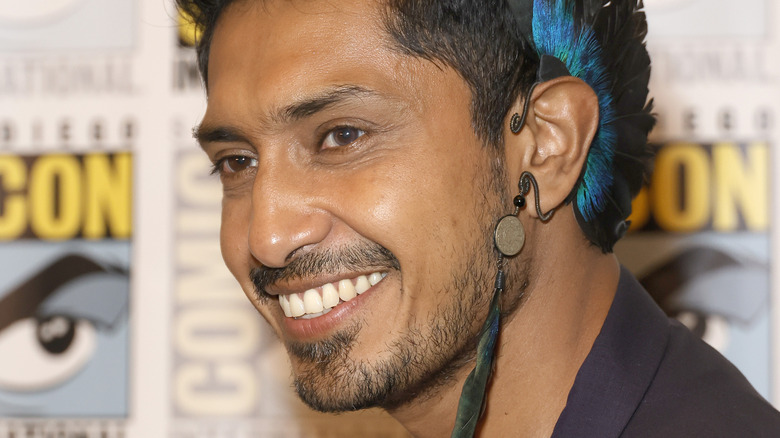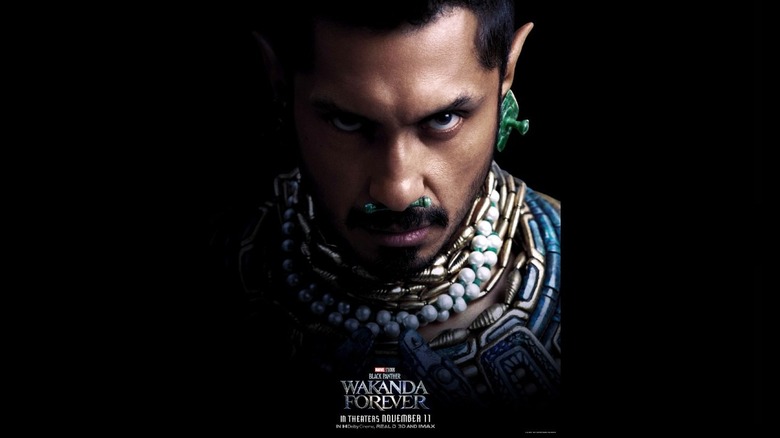Black Panther: Wakanda Forever Concept Artist Discusses The Symbolism Behind Namor's Design - Exclusive
For former Marvel Studios Senior Visual Development artist Anthony Francisco, designing the classic Marvel Comics character Namor for his MCU debut in "Black Panther: Wakanda Forever" came with a detour. Since the MCU has altered Namor's comic book origin from the depths of Atlantis to the underwater kingdom of Talocan in the film, Francisco would have to redesign the look of the character.
The concept artist took a deep dive into unchartered territory, where his studies would take him through the history of Mesoamerica to conceptualize Wakanda's biggest threat yet.
Director Ryan Coogler's "Black Panther: Wakanda Forever" takes place in the aftermath of the loss of King T'Challa (the late Chadwick Boseman). The deep resonance of Boseman's loss was felt in the teaser for the film last summer — where the denizens of Wakanda are shown mourning T'Challa — while the new trailer introduces Namor (Tenoch Huerta) and his Talocan followers as a looming threat to the South African nation.
Francisco, who previously designed the Dora Milaje — the fierce group of Wakandan women warriors in "Black Panther" — sat down in an exclusive interview with Looper to discuss the creative process that went into his design of Namor and the symbolism he incorporated into the character.
Francisco studied Mesoamerican history to inform his design of Namor
Namor was introduced as the child of an American explorer and Atlantean princess in the comic book in Marvel Comics #1 in 1939. For "Black Panther: Wakanda Forever," the MCU moves Namor's home to Talocan, meaning Anthony Francisco would have to help forge a new identity for the character. He found inspiration in the plight of the Olmecs, Aztecs, and Mayans.
"I looked through a lot of folklore, documentaries on Mesoamerica, and information about their gods and things like that," Francisco recalled for Looper. "What you'll see in the design is a celebration of the culture of Latin America and Mexico. It is really a treat to be able to design for that, and that's true to form with the way I do designs. I have the main 80% of it being the vision, the aesthetic of Mesoamerica, but I also added some African, Egyptian as well as Chinese ancient tribal elements."
To get into the headspace of ancient Mesoamerica, Francisco said he transported his mind to the time period. "I was pretending I was a graffiti artist in that time, studying Mayan glyphs," Francisco explained. "I learned so much from those glyphs while trying to understand them and reading about them through the research. I saw how they would explain their stories. I know Marvel wanted the design to look Mesoamerican, so I designed the necklace to look original by pretending I was there."
Namor's necklace symbolizes life and death
Anthony Francisco told Looper that Namor's costume materialized in a dream after watching documentaries on Mesoamerica. In the "Wakanda Forever" trailer, M'Baku (Winston Duke) refers to Namor as Kukulkan — the feathered serpent who brings life and death — and the vision Francisco had to design the warrior's detailed necklace was a reflection of the creature.
"I was thinking of ways to symbolize it: I had two serpents surrounding the sun, which is a pearl in the middle of the necklace," Francisco explained. "The two serpents represent life and death. Your interpretation depends how you see the two serpents, either swallowing the sun or presenting it, thus symbolizing life or death. The interpretation really depends on who is looking at it."
The makers of the Marvel Legends line, Hasbro, is apparently looking at the glass as half-full, because they've already immortalized Namor and his necklace in plastic as an action figure (see above).
"Black Panther: Wakanda Forever" is in theaters November 11. You can follow Anthony Francisco's work at his website, as well as his Twitter and Instagram accounts. Francisco's artwork and storytelling is also featured on the website for his new multimedia project, "Creature Chronicles."


